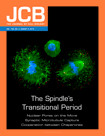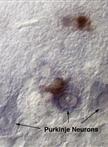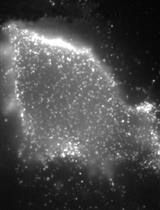- EN - English
- CN - 中文
Immunolabelling of Thin Slices of Mouse Descending Colon and Jejunum
小鼠降结肠和空肠薄切片的免疫标记
发布: 2013年10月20日第3卷第20期 DOI: 10.21769/BioProtoc.942 浏览次数: 10190
评审: Lin Fang
Abstract
This protocol describes a method for efficient immunolabelling of thin tissue slices containing a few rows of intact intestinal crypts, which yields large numbers of them being oriented favorably for recording stacks of optical sections aligned with the crypt long axis (Bellis et al., 2012). The latter can then be used for cell positional analysis, 3D-reconstruction and -analysis. The simple epithelium lining the small intestine is organized into contiguous crypts of Lieberkühn (Potten, 1998; Barker et al., 2012; De Mey and Freund, 2013) several of which making up a crypt/villus unit. Each crypt is a multicellular proliferation unit with a tight hierarchical organization. Under steady state conditions, the epithelium is continuously and rapidly renewed, driven by divisions of multipotent intestinal SCs near the crypt base and cell removal from the villus tip. Techniques for analyzing the organization of the crypts play an important role in the field. Maximal efficiency is obtained by using optical sections obtained from confocal scanning and/or Nomarski optics passing through the center of the longitudinal crypt axis to view the crypt as two cell columns of hierarchical lineage starting from cells positioned at or near the crypt base. This enables positional analysis of certain cellular capacities like performing DNA synthesis, undergoing mitosis and apoptosis (Caldwell et al., 2007; Fleming et al., 2007; Quyn et al., 2010), responding to injury (Potten et al., 1997), or expressing genes (Barker et al., 2012; Bjerknes et al., 2012; Itzkovitz et al., 2012). Our protocol has allowed us to demonstrate that some divisions are asymmetric with respect to cell fate and the occurrence of oriented cell division (OCD) in 80% of the proliferating cells in the upper stem cell and transit amplifying zones. It has further revealed planar cell polarities which are important for crypt homeostasis and stem cell biology and alterations in apparently normal crypts and microadenomas of mice carrying germline Apc mutations shedding new light on the first stages of progression towards colorectal cancer.
Materials and Reagents
- Mouse
- Isoflurane gas (Abbott Laboratories)
- Dissection pan wax (black) (Fisher Scientific, catalog number: S17432 )
- Pipes
- HEPES
- EGTA
- MgSO4
- Triton-X-100
- Taxol (Paclitaxel from Sigma-Aldrich, catalog number: T7191 )
- PBS
- NaN3
- Sodium deoxycholate
- BSA 10% in PBS
- Tri-sodium citrate dihydrate (Merck KGaA, catalog number: 567446 )
- 1 N HCl (1 mol/L) (Merck KGaA, catalog number: 1090571000 )
- Paraformaldehyde (PFA) 16% solution, EM grade (Electron Microscopy Sciences, catalog number: 15710 )
- Phalloidin-Alexa 568 (Life Technologies, Molecular Probes®, catalog number: 12380 )
Note: The Alexa type may be chosen according to available other fluorophores. - DAPI: 1 mg/ml stock solution in PBS (stored at 4 °C)
- Alexa-labeled secondary antibodies. In our study, these were from Life Technologies- Molecular Probes goats anti (species) IgG (H + L) and all highly cross-adsorbed to assure absence of cross-species-reactivity.
Note: For any combination of primary antibodies, a choice of corresponding secondary antibodies and fluorophore wavelengths has to be made. When as in our case, Phalloidin-Alexa 568 (red fluorescence) is used for marking microfilaments made of actin, and DAPI for DNA, secondary antibodies are usually labelled with Alexa 488 (green fluorescence) and Alexa 647 (far-red fluorescence). The latter is recommended for antigens giving weak signals, since it is very well detected by current confocal microscopy systems. When Phalloidin could not be used, Alexa 568 or 555 (red fluorescence) labelled secondary antibodies could be used in addition.
Note: In our study, no commercial primary antibodies were used. - Prolong Gold mounting medium without DAPI (Life Technologies, catalog number: P36934 )
- 2x PHEM (see Recipes)
- Fixative (see Recipes)
- 20 mM Sodium citrate buffer (see Recipes)
- Solutions of primary affinity-purified antibodies (see Recipes)
- Solutions of secondary antibodies (see Recipes)
Equipment
- Thermostatic water bath
- Tem Sega evaporator apparatus for isoflurane anesthesia
- Scissors 3 cm and microscissors (Fine Science Tools)
- Forceps n°5 (Fine Science Tools)
- Binocular
- 30 G 1/2” needles
- U-100 Insulin syringe + needle
- Microscope slides 76 x 26 x 1.1 mm
- 1.5 ml Eppendorf tubes
- Micropipettes
- 18 x 18 mm glass coverslips Nr. 1
- Fast confocal microscope (we use a Leica SP5 confocal microscope)
- 63x NA 1.4 oil immersion lens
Procedure
文章信息
版权信息
© 2013 The Authors; exclusive licensee Bio-protocol LLC.
如何引用
Readers should cite both the Bio-protocol article and the original research article where this protocol was used:
- Bellis, J., Duluc, I., Freund, J. and De Mey, J. R. (2013). Immunolabelling of Thin Slices of Mouse Descending Colon and Jejunum. Bio-protocol 3(20): e942. DOI: 10.21769/BioProtoc.942.
-
Bellis, J., Duluc, I., Romagnolo, B., Perret, C., Faux, M. C., Dujardin, D., Formstone, C., Lightowler, S., Ramsay, R. G., Freund, J. N. and De Mey, J. R. (2012). The tumor suppressor Apc controls planar cell polarities central to gut homeostasis. J Cell Biol 198(3): 331-341.
分类
干细胞 > 成体干细胞 > 肠道干细胞
生物化学 > 蛋白质 > 免疫检测 > 免疫染色法
您对这篇实验方法有问题吗?
在此处发布您的问题,我们将邀请本文作者来回答。同时,我们会将您的问题发布到Bio-protocol Exchange,以便寻求社区成员的帮助。
Share
Bluesky
X
Copy link













